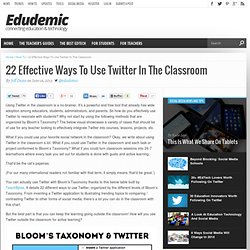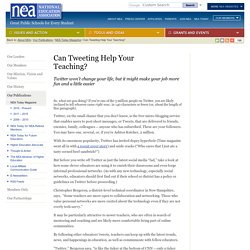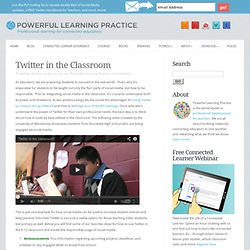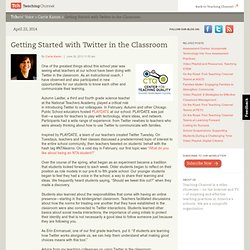

22 Effective Ways To Use Twitter In The Classroom. Using Twitter in the classroom is a no-brainer.

It’s a powerful and free tool that already has wide adoption among educators, students, administrators, and parents. So how do you effectively use Twitter to resonate with students? Why not start by using the following methods that are organized by Bloom’s Taxonomy? The below visual showcases a variety of cases that should be of use for any teacher looking to effectively integrate Twitter into courses, lessons, projects, etc. 50 Ways to Use Twitter in the Classroom. Many critics of Twitter believe that the 140-character microblog offered by the ubiquitous social network can do little for the education industry.
They are wrong. K-12 teachers have taken advantage of Twitter’s format to keep their classes engaged and up-to-date on the latest technologies. The following projects provide you and your students with 50 ways to Twitter in the classroom to create important and lasting lessons. 1. Tweet about upcoming due dates or assignments. One of the simplest ways that teachers can use Twitter in the classroom involves setting up a feed dedicated exclusively to due dates, tests or quizzes. 2. Subscribe to different mainstream and independent news feeds with different biases as a way to compare and contrast how different perspectives interpret current events and issues. 3.
The modern-day classroom has to account for a variety of learning styles in... Making ESL students feel welcome at their new school is vital to their success... 4. 5. 6. 7. 8. Can Twitter be Used in the Classroom? Twitter in the Classroom: Watch This Teacher Engage Shy Students in Learning History. Still skeptical about the value of using Twitter as a tool to engage introverted students in classroom lessons?

You're not alone. A recent survey of almost 2,000 teachers found that half think that using Twitter (and Facebook) in the classroom "is harmful to the learning experience. " But, Los Angeles history teacher Enrique Legaspi disagrees with the naysayers. Last year he went to a workshop that discussed ways to use Twitter in teaching and now his students—even the shy ones—at Hollenbeck Middle School in East L.A. are speaking up more.
In the video above, you can watch Legaspi teach a World War I lesson, and hear him explain how Twitter has revolutionized discussions, helped him know more about his shy students, and modify his instruction to meet their needs. Can Tweeting Help Your Teaching? So, what are you doing?

If you’re one of the 3 million people on Twitter, you are likely inclined to tell whoever cares right now, in 140 characters or fewer (or, about the length of this paragraph). Twitter, on the small chance that you don’t know, is the free micro-blogging service that enables users to post short messages, or Tweets, that are delivered to friends, enemies, family, colleagues -- anyone who has subscribed. These are your followers. You may have one, several, or, if you’re Ashton Kutcher, 2 million. With its enormous popularity, Twitter has invited dopey hyperbole (Time magazine went all in with a recent cover story) and snide cracks (“Who cares that I just ate a tasty corned beef sandwich?”) But before you write off Twitter as just the latest social media “fad,” take a look at how some clever educators are using it to enrich their classrooms and even forge informal professional networks.
Twitter in the Classroom. As educators, we are preparing students to succeed in the real world.

That’s why it’s imperative for students to be taught not only the ‘fun’ parts of social media, but how to be responsible. Prior to integrating social media in the classroom, it’s crucial to understand both its power and limitations. In two previous blogs we discussed the advantages for using Twitter to create a strong network and how to leverage your PLN with hashtags.
Once educators understand the power of Twitter for their own professional needs, the next step is to think about how it could be best utilized in the classroom. The following video (created by the University of Minnesota) showcases students from Roosevelt High School who are being engaged via social media. This is just one example for how social media can be used to increase student interest and keep parents informed. Announcements. Getting Started with Twitter in the Classroom. One of the greatest things about this school year was seeing what teachers at our school have been doing with Twitter in the classroom.

As an instructional coach, I have observed and also participated in new opportunities for our students to know each other and communicate their learning. Autumn Laidler, a third and fourth grade science teacher at the National Teachers Academy, played a critical role in introducing Twitter to our colleagues. In February, Autumn and other Chicago Public School educators hosted PLAYDATE at our school. PLAYDATE was just that—a space for teachers to play with technology, share ideas, and network. Participants had a wide range of experience: from Twitter newbies to teachers who were already thinking about how to use Twitter to communicate with families.
Inspired by PLAYDATE, a team of our teachers created Twitter Tuesday. Over the course of the spring, what began as an experiment became a tradition that students looked forward to each week. 60 Ways to Use Twitter in the Classroom by Category. Teacher’s Guide to Using Twitter in the Classroom - ExamTime. This guide brings together some of the best tips on using Twitter in the classroom.

We’ve sourced some of the best education blogs from the web to bring you these useful resources from influential bloggers. Our tips come from Jeff Dunn from Edudemic and Christopher Pappas from eLearning Industry plus other education bloggers who really know what they are talking about.